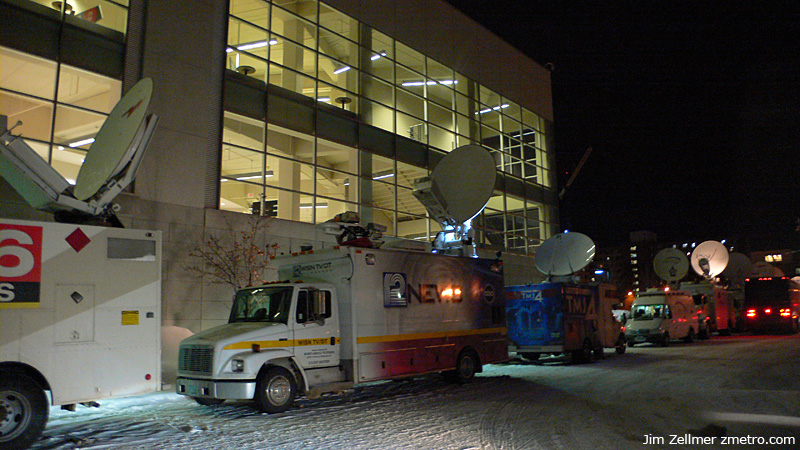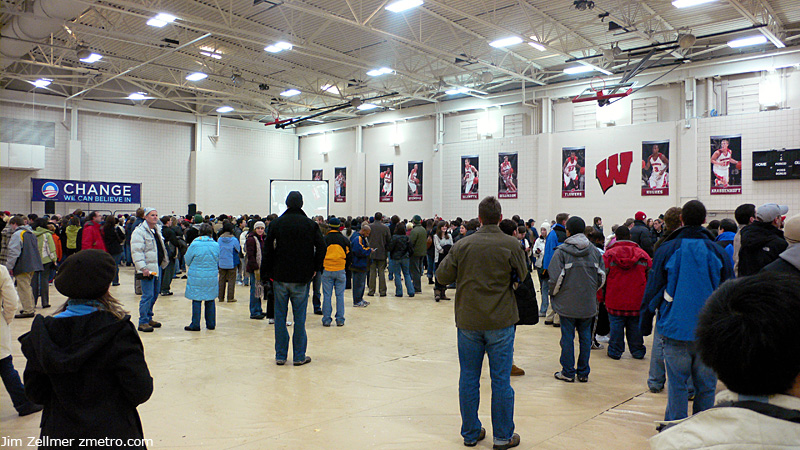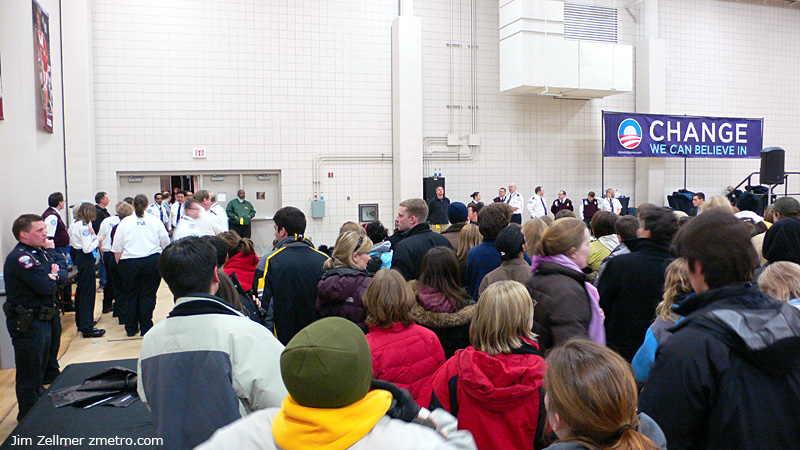I phoned Senator Kohl’s Washington office [(202) 224-5653] regarding his vote against the Dodd/Feingold telco immunity amendment yesterday. The telephone operator said that Senator Kohl supported an amendment that would have the government (we taxpayers) defend the telcos in court and that these cases should be heard in a court where intelligence information could be shared. John McCain voted with Senator Kohl, while Barack Obama voted with Russ Feingold and Hillary Clinton did not vote. David Isenberg has more as does Dave Farber. The Electronic Frontier Foundation posted a summery here.
Monthly Archives: February 2008
Barack Obama in Madison
A few photos from a late arriving visitor to the University of Wisconsin’s Kohl Center.


While I did not arrive early enough to catch the speech inside the Kohl Center, I always find it interesting to note the political opportunism during these events. Governor Doyle, Milwaukee Mayor Tom Barrett and local Mayor Dave Cieslewicz all rated a nod from Obama. John Kerry’s 2004 appearance with Bruce Springsteen included a number of local politicians, including Elizabeth Burmaster, Wisconsin Department of Public Instruction Superintendent (a nonpartisan position).
Finally, a few Ron Paul supporters promoted their candidate in front of the proceedings.
The List: The World’s Best Places to Be an Immigrant
Throughout the developed world, countries are tightening up border security, building fences, and raising citizenship requirements. But there are still a few places left that are willing to say: “Give us your huddled masses.”
Microsoft will pay high price for failing to learn history lessons
It’s the metaphors and similes that get me. It’s a shotgun marriage, declared one commentator, ‘with Google holding the gun’. Putting Microsoft and Yahoo together, said another, was like trying to produce an eagle from an alliance of two turkeys.
T his is unfair. Microsoft isn’t a turkey, but a profitable, boring mastodon that entertains fantasies about being able to fly. Yahoo, for its part, is an ageing hippy who invented hang- gliding but aspired to fly 747s and then discovered that he wasn’t very good at it. The mastodon hopes that by employing the hippy it will learn to hang-glide. The hippy’s feelings about the whole deal are plain for all to see.
Microsoft’s $44.6bn offer of cash plus shares for Yahoo has got everyone in a spin, partly because of its sheer size but mostly because they fondly imagine it heralds an exciting future. At last, they think – something that might stop the inexorable advance of Google toward world domination! If that’s what they’re hoping for, then this ain’t it, alas. This isn’t the opening of a new chapter in the history of the computing business, but – as John Markoff observed in the New York Times – ‘the final shot of yesterday’s war’. And even if the merger does take place in a reasonable timescale – and if it can be made to work – it won’t make much of a dent in Google.
Wisconsin’s Chocolate Delta
OAKS Candy Corner in Oshkosh is a chocolate mirage.
Its gingerbread exterior yields to an interior that in winter is as sugary warm as the inside of a circus peanut and in summer is as refreshing as a wax Coke bottle. It smells like caramel corn and cocoa butter rubbed into the floorboards with a pair of Red Wing boots. It’s the shop just around the corner in an unremittingly blue-collar part of an unremittingly blue-collar town. It shouldn’t still be there, but there it is.
If Oaks Candy is a mirage, then the Hughes Homaid Chocolate Shop, less than half a mile away, is a figment of Wisconsin’s imagination. An 80-year-old bungalow two blocks from Lake Winnebago, it has only a small neon sign to state its trade and a full-blown candy-making operation in its basement.
But Oshkosh isn’t the only caretaker of these unlikely sweet dreams. There’s Beerntsen’s in Manitowoc, with its plate lunches and ice cream sodas; Wilmar Chocolates in Appleton, with its old-time awnings and row of state-fair prizes on the south wall; Kaap’s in Green Bay, with its jar of jawbreakers on the counter; Seroogy’s in De Pere, with its magical whipped-chocolate-filled “meltaways”; and more, much more.
Back to Reality: Sunrise After Madison’s Big Snowstorm

After pondering summer with a few photos, we’re back to reality blowing snow this morning. I think this photo captures our existence rather well, at the moment. Note the snow depth next to my snowblower’s intake. 13.3″ according to Channel3000.
The streets I drove were in good shape early today.
Thinking of Summer: Antibes
 This image of a woman jumping from a rocky cliff into the Mediterranean was taken from a “people’s beach” adjacent to the Hotel du Cap [Clusty search]. A useful image as we Madisonians face another snow shoveling event. Clusty search: Antibes.
This image of a woman jumping from a rocky cliff into the Mediterranean was taken from a “people’s beach” adjacent to the Hotel du Cap [Clusty search]. A useful image as we Madisonians face another snow shoveling event. Clusty search: Antibes.
satellite view
Riding That Train, A Long Commute
At 6 on a Wednesday morning, Jim Bourgart is already 15 minutes into a 175-minute commute by foot, bus, train and foot again. From downtown San Francisco he’ll catch an Amtrak motor coach to the Emeryville station, where he’ll sit 20 minutes on a hard plastic bench waiting for the 6:40 to Sacramento.
He doesn’t mind as long as he is moving. It is the lost sleep time in the waiting room that hurts. Since the Capitol Corridor runs both the bus and the train, you’d think it could tighten the time-cushion allowed for traffic that never appears on the eastbound bridge.
“I could use those extra 20 minutes, or even 10 or 5,” says Bourgart, who starts his day with a 12-minute walk in the dark from his SoMa condo to the bus stop at the Market Street entrance to Bloomingdale’s. “Every minute counts, especially in the morning.”
The Capitol Corridor is a line made possible by the voters, who in 1990 approved Prop. 116 to provide state funding for intercity passenger rail service. Until 1998, there were only four trains each direction per day and the morning commute was essentially westbound only. Now there are 16 roundtrips. The State of California owns the rolling stock, Union Pacific owns the tracks, BART supplies administration, Amtrak staffs the trains and stations and a joint powers authority oversees it. The Capitol Corridor is like Caltrain with more layers of agencies.
Fixing US broadband: $100 billion for fiber to every home
The US is in desperate need of 100Mbps “big broadband.” That’s the conclusion of a new report from EDUCAUSE (PDF), a group that represents IT managers at over 2,200 colleges and universities. But these 100Mbps connections are coming slowly; in the meantime, countries like Japan already have them. To avoid falling further behind, the report calls for a national broadband policy to be passed this year, one that includes $100 billion for a fiber-to-the-home infrastructure that will connect every household and business in the country.
The report opens by citing the familiar, dreary facts: US broadband might now be widely available, but it’s slow and relatively expensive. Between 1999 and 2006, the US fell from third place to 20th in the International Telecommunications Union’s broadband usage measurements. When it comes to average connection speeds, the US isn’t beaten just by Japan but also by France, Korea, Sweden, New Zealand, Italy, Finland, Portugal, Australia, Norway, Luxembourg, the United Kingdom, and Germany. And it’s not about population size or density, either; Finland, Sweden, and Canada beat us on most broadband metrics despite having lower population density. Finally, we’re getting beat on price, coming in 18th worldwide when it comes to cost per megabyte.
Eureka! It Really Takes Years of Hard Work
WE’VE all heard the tales of the apple falling on Newton’s head and Archimedes leaping naked from his bath shrieking “Eureka!” Many of us have even heard that eBay was created by a guy who realized that he could help his fiancée sell Pez dispensers online.
The fact that all three of these epiphany stories are pure fiction stops us short. As humans, we want to believe that creativity and innovation come in flashes of pure brilliance, with great thunderclaps and echoing ahas. Innovators and other creative types, we believe, stand apart from the crowd, wielding secrets and magical talents beyond the rest of us.
Balderdash. Epiphany has little to do with either creativity or innovation. Instead, innovation is a slow process of accretion, building small insight upon interesting fact upon tried-and-true process. Just as an oyster wraps layer upon layer of nacre atop an offending piece of sand, ultimately yielding a pearl, innovation percolates within hard work over time.
“The most useful way to think of epiphany is as an occasional bonus of working on tough problems,” explains Scott Berkun in his 2007 book, “The Myths of Innovation.” “Most innovations come without epiphanies, and when powerful moments do happen, little knowledge is granted for how to find the next one. To focus on the magic moments is to miss the point. The goal isn’t the magic moment: it’s the end result of a useful innovation.”